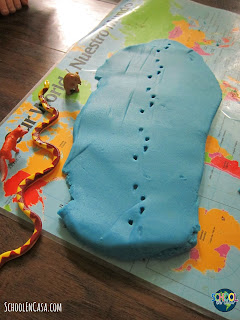Playdough is not just for kindergarten! We've used it this week to integrate science, math, and language. Great content plus playdough is a winner every time.
Last week Miss Braveheart (3 years old) and I read Las huellas de los animales by Arthur Dorros. It's out of print now, but you can still pick up a used copy easily. I highly recommend it for children up through 2nd grade. It's not difficult to read, but gives a good amount of science content.
Today Miss Adventuress (6, 1st grade) joined the fun, too. We read Cadenas alimentarias del desierto by Bobbie Kalman, and Mi casa en el desierto by Sharon Gordon. Cadenas alimentarias del desierto is a content-rich book that I would recommend up through 4th grade. At lower levels, I would pick and choose the content I shared. Mi casa en el desierto was good for reading with Miss Braveheart, and was good reading practice for Miss Adventuress. The text is large, and there is plenty of space for both the English and the Spanish on each page. We read the books, looked at illustrations, and thought about life in the desert.
And we made playdough! You can buy it, but making it is so much more fun, aside from being very inexpensive. Plus, you're integrating math if you allow children to make it themselves! Here's my very favorite playdough recipe, that has never yet failed me:
PLAYDOUGH RECIPE
1 cup flour
1/2 cup salt
2 tsp. cream of tartar
2 Tbs vegetable oil
1 cup water
Food coloring (optional...I like to use Wilton gel colors)
1. Combine dry ingredients with whisk in pan.
2. Add oil, water, and food coloring if desired. Whisk together.
3. Heat over medium-low heat on stove.
4. Stir with spatula until it turns into a dough.
5. Turn out onto wax paper. Allow to cool for a minute, then knead until smooth.
We pulled out a few desert animals from our bucket, and rolled out the playdough on a placemat. Then I had Miss Braveheart close her eyes while I made footprints in the playdough.
Can you tell it was the desert fox? She guessed it correctly, too. Miss Adventuress was also watching and guessing.
The second time, the mouse hopped across the playdough. It gave us a good opportunity to see that marks left behind are not always made by feet...the mouse's body and tail left imprints in this case!
And last, the snake slithered by. Here Miss Braveheart is putting the snake in its track to verify that it fits. This activity is really great for talking about how animals move, and how scientists can tell what animals have been in a certain place, even though those animals are usually hiding. The children are using mathematical reasoning to guess which animal made which print. For older children, you could easily increase the difficulty level by having more available animal options. Or you could just ask them to tell you everything they can about an animal based on the tracks it left behind.
After the playdough, we went outside to see if we could find any animal tracks in the yard. It hasn't rained recently here, so it was a little difficult. We did find some clues about the animals that had visited, though.
And we found this, which we thought was a clue, perhaps fecal matter...
...but then we discovered this small fallen branch with identical somethings attached to it. And we talked about how scientists make their best guess based on the evidence they have, and then they change their best guess when they get new evidence. Miss Adventuress remembered that we bought a field guide to the trees in our state, and went to get it to identify this tree, and try to figure out what was attached to this branch.
Since we didn't find a lot of tracks, we decided to make a track trap. Miss Adventuress is sprinkling flour on the grass, and then putting some grapes in the middle. She'll check it in the morning to see if anything has been here, and try to guess what it might have been based on the tracks left.
Miss Braveheart made a track trap on a rock, also with grapes in the middle. We'll check this one in the morning as well, and hopefully we'll find that one or more animals has been out in the meantime!
You could easily add to the language component by having children narrate or write about what they discovered about animal tracks. I also named new animals for Miss Braveheart, working on new vocabulary. I may make cards with desert animals on them for both girls as well.
After all of this work, they played with playdough more, in free play. Though it just looked like fun, they were actually learning more about spatial reasoning as they made little sculptures out of playdough, and strengthening hand muscles that are needed for writing.
So much learning can be easily integrated to create fascinating, memorable learning experiences! How do you integrate learning in your classroom? I'd love to hear!
Virginia of School en casa is a teacher by profession, now homeschooling 4th grade, 1st grade, and preschool bilingually. She loves integrating Montessori theory into her teaching, and sharing their experiences on her blog!












No comments:
Post a Comment